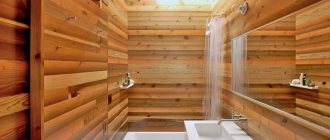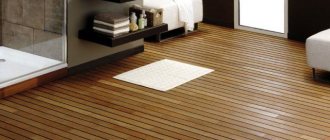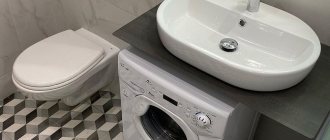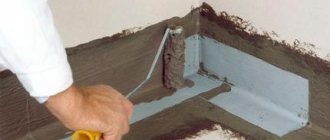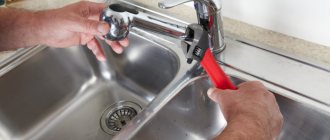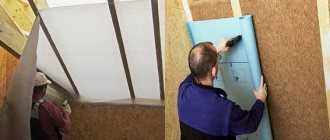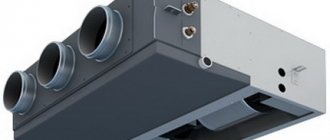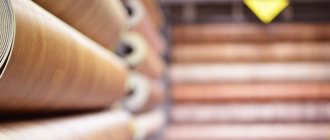Do you think that the only optimal option for finishing the floor in the bathroom is tiles? You are wrong - it can be called a traditional material, but by no means the only one, because there are several other interesting alternatives. One of them is linoleum. Of course, many will immediately have a question: is it possible to lay this specific flooring material in a room with such difficult operating conditions? To find the answer, you need to approach the matter thoroughly: consider the pros and cons of cladding, understand the types and specifics of installing linoleum for the bathroom, read the reviews of those who have already decided to take such a step, and also evaluate from the photo how the material looks after installation .
Bathroom floor: what should it be like?
Traditionally, the bathroom floor is tiled.
This material is considered the most suitable for a humid indoor environment, but it also has a number of negative sides - expensive, slippery, the joints between individual tiles get dirty over time, and cold. In this regard, consumers are turning their attention to linoleum from the point of view of savings and a number of advantages.
Some are categorically against such coverage, while others are in favor of it. To deal with this issue, we will analyze in detail all the pros and cons, drawing information from real reviews.
conclusions
Since ceramic tiles are a rather cold material, many are looking for a practical and inexpensive replacement. Linoleum is a reliable and attractive material with many practical properties. This coating can be used in any premises. You just need to follow the technology for preparing the base and gluing the material.
Since the wooden base constantly changes shape and size under the influence of temperature changes, linoleum perfectly compensates for these changes. This material is preferable to others when finishing bathroom flooring in a wooden house.
Disadvantages: you can’t live without them
Why shouldn't you lay linoleum in your bathroom? Skeptics on this question cite a number of disadvantages of such flooring in an environment with high humidity:
- Mold and mildew can develop under linoleum. The fact is that the upper waterproof layer gives the material moisture resistance, and the base is made of felt and other spongy material that perfectly absorbs and retains moisture. This can only happen if the basic rules of installation technology are violated.
- Slippery, you can fall and hit yourself. For the bathroom, choose types of material with a ribbed anti-slip surface or lay rugs.
- The surface of the linoleum will be pressed under the weight of heavy objects - a cabinet, a bathtub. If you purchase the cheapest and low-quality material, then this will most likely happen in any other room.
- Linoleum will deteriorate from exposure to chemical detergents. High-quality (and more expensive, accordingly) will not deteriorate.
If you do not purchase the cheapest materials from a building materials store, and also learn how to lay linoleum correctly or entrust this matter to professionals, then all the negative characteristics will lose their power.
For the bathroom, choose linoleum with a ribbed, non-slip surface
Work order
Before you begin the renovation, you should decide on the choice of materials and the type of work to be performed. If everything is correctly calculated and prepared in advance, the bathroom renovation will go smoothly. The operating procedure is as follows:
- calculation and purchase of necessary building materials;
- floor leveling;
- decorative floors;
- determination of interior styles and details;
- door installation.
- if necessary, dismantling and replacing supply pipes;
- decorative wall decoration;
- choosing the type of toilet, determining the location and method of its attachment;
- alignment and repair of walls and ceilings;
- dismantling of doors and covering materials, ceilings, floors;
- toilet installation;
Advantages: we are for it!
In contrast to the negative opinion of opponents of laying linoleum in the bathroom, we list all the advantages of such a coating:
- If you select special types of materials and follow the installation technology, the floor covering will last for many years.
- Integrity. The absence of seams is one of the main advantages of linoleum - the appearance of the floor will not deteriorate over time, it is easier to wash and wipe it with water.
- Resistant to moisture penetration. If you lay linoleum correctly, then neither mold nor fungi will form.
- It is easier to install compared to tiles - it is easier to make cutouts for pipes, toilets, and bathtub legs.
- Attractive appearance - in stores you can choose a variety of designs of materials for covering the floor in the bathroom.
These are just some of the advantages that make it possible to install linoleum in your bathroom. But keep in mind that for this you need to choose only special types of material.
Summarizing
Practice shows that linoleum in the bathroom is not a stupid whim, but a completely reasonable decision. Of course, there are a number of nuances related to protection from moisture penetration under it, but these problems can be solved with the help of high-quality glue and direct hands; otherwise, this coating has no serious drawbacks.
The video in this article shows an example of laying factory-installed linoleum on a wall using professional equipment.
In the comments, you can share your own experience of laying linoleum in rooms with high humidity and seek advice on any problems that arise.
Which to choose?
There are a lot of linoleums sold on the building materials market. They are:
- Natural. They are made from cork, jute fiber, wood shavings and linseed oil. They have high wear-resistant characteristics, but are not suitable for wet rooms.
- Nitrocellulose. Very rarely used in household repairs. The main component – colloxin – in combination with other chemical additives makes the material resistant to combustion.
- Alkyd with a jute fiber base. These types of linoleum are laid mainly in public transport.
- Relin. Made from crumb rubber and rubber mass. It is ideal for use as a floor covering for industrial plants.
- PVC with synthetic base. The most popular type is what is sold to a wide range of consumers. Used in residential areas.
According to damage resistance classes, linoleums are divided into residential premises (classes 21-23), public places (classes 31-34) and industrial enterprises (classes 41-43).
To cover the floors in the bathroom, we choose PVC linoleum with the following indicators:
- High moisture resistance and wear resistance. Pay attention to the top protective layer.
- Low porosity of the base. This linoleum will absorb less water.
- The softness and thickness of a coating material, measured at room temperature. Also ask sellers about possible deformation during local heating.
- Roughness. Your safety when water gets on the floor depends on the slip coefficient.
- Possibility of technology for gluing joints, if any.
- And, of course, a beautiful pattern that will best suit the design of the room.
Linoleum in the bathroom
Note that a special coating for the bathroom will be expensive. Its price is equivalent to the cost of the cheapest tiles. But it’s better not to skimp on your own safety and health.
More recently, some innovation has appeared - linoleum on bathroom walls, which is similar in appearance and structure to vinyl laminate tiles. Wall-mounted linoleum for a bathroom differs from floor linoleum only in the thickness of the layer - the material will not be subject to any load, therefore it has a low degree of wear resistance.
Advice. Before purchasing flooring, read reviews about different types of linoleum on the forums. Also ask sellers in detail about all the qualities of the material.
General requirements and material selection
If the work technology is followed, linoleum is perfect for the bathroom
There is an opinion that roll coverings are not intended for rooms with a risk of water formation on the floor surface and high residual humidity. Despite this, linoleum can be laid in the bathroom.
Only this applies to specialized types of coating, which will be laid using the appropriate technology.
Among the general requirements for linoleum, the following rules must be observed:
- water resistance - the outer layer of the front covering must be covered with a special film that prevents the destruction of the material under the influence of moisture and water;
- substrate - the bottom layer of linoleum should be made of a material that does not absorb moisture. The coating cannot be used on a felt or fleecy substrate. The ideal option is homogeneous semi-commercial linoleum;
- anti-slip properties - for safety reasons, it is necessary to lay a coating with a corrugated or finely perforated front surface with a coefficient of R10 or higher. If water gets in, this linoleum will not slip;
- antibacterial properties - it is desirable that special antibacterial additives are used in the production of the coating to prevent the development of fungus and small microorganisms.
Compliance with the technology of laying on the surface can also be attributed to these requirements, since their compliance guarantees that the coating will provide the declared safety and service life for a long time.
These conditions will be discussed in more detail below. The requirements described above will help you decide which linoleum is best for the bathroom. The wear resistance class and other technical characteristics of the coating are selected individually and depend on the operating conditions of the coating.
Stages of laying linoleum
We remember that it is necessary to follow the installation technology. It is easier to lay the material without gluing. But this option is not suitable for the bathroom.
Linoleum is laid on a perfectly flat floor
To add additional warmth to the floor, it is recommended to use a layer of special types of thermal insulation. For apartments and houses with a floor heating system, this recommendation is not relevant.
Main stages:
- Surface preparation. For relatively flat floors, fill small cracks and depressions. If the floor is not level, it is better to make a cement screed and use special self-leveling mixtures for final leveling.
Attention! There should be a flat floor under the linoleum. If there are irregularities on the base, the material will lie incorrectly and its service life will be significantly reduced.
- We are waiting for the concrete to dry. After 2-5 days (depending on the air temperature), you can begin laying linoleum. We recommend that you first spread the linoleum on a flat surface so that it is leveled and does not create ripples or waves during work.
- Lay the material on glue or mastic. Mastic is most often used by specialists when laying it on a concrete floor. It is applied to the base and to the material itself in a layer of 0.5 cm.
Advice. For gluing linoleum in the bathroom, only special chloroprene-based glue is suitable. Water-soluble types, which are used for standard repair work, are not suitable. Working with a special adhesive mass requires certain skills; beginners cannot cope with it.
- We unwind and lay the roll overlapping all the walls. The joints with the wall must be coated well with mastic. The mastic will dry completely after 3 days.
- If the room is large and the linoleum had to be laid in more than one piece, then you will end up with seams. The material in the area of the joints is laid with an overlap of 10-12 cm. We process them using the cold method only after the mastic has completely dried.
- Finally we install the baseboard.
- In order to make a smooth transition from the bathroom to the corridor, we install a threshold.
To protect yourself, we recommend placing anti-slip mats made specifically for the bathroom on the floor. They are based on rubber or polyurethane.
As you can see, there are no contraindications to installing linoleum on the bathroom floor. Special types of materials are sold, there is a step-by-step installation technology. Don't be afraid to experiment! The flooring will perfectly complement the design of your room and will last you a long time.
Types of coverage
Modern linoleum is made from various materials on a natural and synthetic basis.
According to the degree of wear resistance, it is divided into several classes:
• 21-23, or household (for living rooms);
• 31-34, or semi-commercial (for public places);
• 41-43, or commercial (for the industrial sector).
Depending on the structure, linoleum can be homogeneous or heterogeneous:
- Homogeneous. This is a material with a uniform texture, thickness from 1.5 to 3 mm. It has a simple color, often for no reason. It is resistant to abrasion and retains its appearance for a long time.
- Heterogeneous. It consists of several layers. Its thickness is from 2 to 6 mm. Available in different colors, patterns and designs.
- Without a plinth is the best option for decorating bathrooms. It has a thickness of 1.2-1.6 mm and is suitable for level ground.
Synthetic-based PVC coverings are used for bathrooms. Also on sale are linoleum on foam plastic, coatings with improved thermal insulation characteristics, etc.

